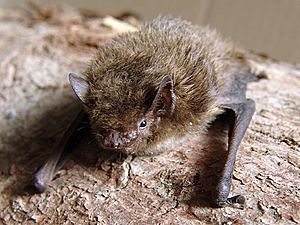Nathusius's pipistrelle facts for kids
Quick facts for kids Nathusius' pipistrelle |
|
|---|---|
 |
|
| Conservation status | |
| Scientific classification | |
| Genus: |
Pipistrellus
|
| Species: |
nathusii
|
Nathusius' pipistrelle (Pipistrellus nathusii) is a small bat that looks a lot like the common pipistrelle. For a long time, people didn't notice it much, but it actually lives all over Europe. Two German scientists, Alexander Keyserling and Johann Heinrich Blasius, first described this bat. They named it after Hermann von Nathusius, who helped them with their research.
Contents
What Does the Nathusius' Pipistrelle Look Like?
This bat is quite small. Its head and body are about 4.6 to 5.5 centimeters (about 2 inches) long. Its wings can spread out to 22 to 25 centimeters (about 9-10 inches). The forearm, which is part of its wing, measures 3.2 to 4.0 centimeters. It weighs about 6 to 15.5 grams, which is like a few grapes.
The bat's fur is a medium-dark reddish-brown on its back. The tips of its fur are often lighter. On its belly, the fur is pale brown. Its fur is longer and not as evenly colored as the common pipistrelle's fur. This bat is also a bit bigger than the common pipistrelle and has wider wings. Its face, ears, wings, and tail are all dark in color.
Where Do Nathusius' Pipistrelles Live?
Nathusius' pipistrelle can be found from Western Europe all the way to the Ural Mountains, Turkey, and the Caucasus. These bats are very migratory. This means bats from northern and eastern areas fly southwest for the winter. They like to live in parks and light woodlands, often close to water.
They are more common in Central and Eastern Europe. In western areas, they are usually rare winter visitors. However, new groups of breeding bats have been found there recently. In Ireland and Britain, people used to think they were just occasional visitors. There were only a few sightings, including some from oil rigs in the North Sea. Now, we know they breed in several places in Britain and Ireland.
Protecting Nathusius' Pipistrelles
Some things can be dangerous for these bats. One threat is losing hollow trees, which they use as homes. Another danger comes from toxic chemicals used to treat wood in buildings. Luckily, the Nathusius' pipistrelle is a protected species in many countries. They also successfully raise their young in bat boxes that people put up for them.
Diet and Life Cycle
This bat comes out early in the evening to hunt for food. It flies in straight lines with quick, deep wingbeats. It usually flies about 3 to 15 meters (10 to 50 feet) above the ground. It eats small to medium-sized flying insects. It especially likes tiny insects called chironomid midges.
Reproduction
Female bats gather in special places called nursery roosts to have their babies. These roosts are often in hollow trees, bat boxes, or sometimes in buildings. Mating happens from July to early September. During this time, male bats gather a group of females in their mating area. In the spring, the females give birth to two young bats.
How Nathusius' Pipistrelles Use Echolocation
Nathusius' pipistrelles use echolocation to find their way around and hunt. They send out high-pitched sounds that bounce off objects. By listening to the echoes, they can create a picture of their surroundings. The sounds they use are between 36 and 62 kilohertz (kHz). The strongest part of their sound is usually at 41 kHz. Each sound they make lasts for about 6.9 milliseconds.


